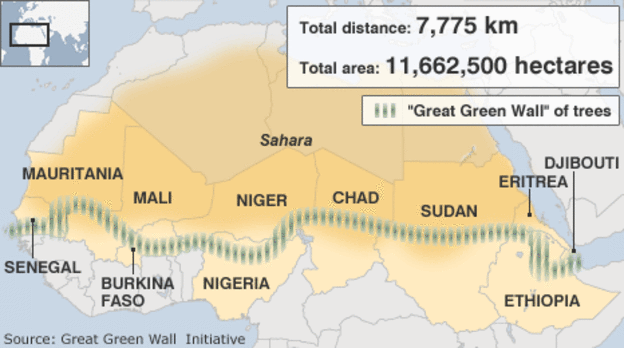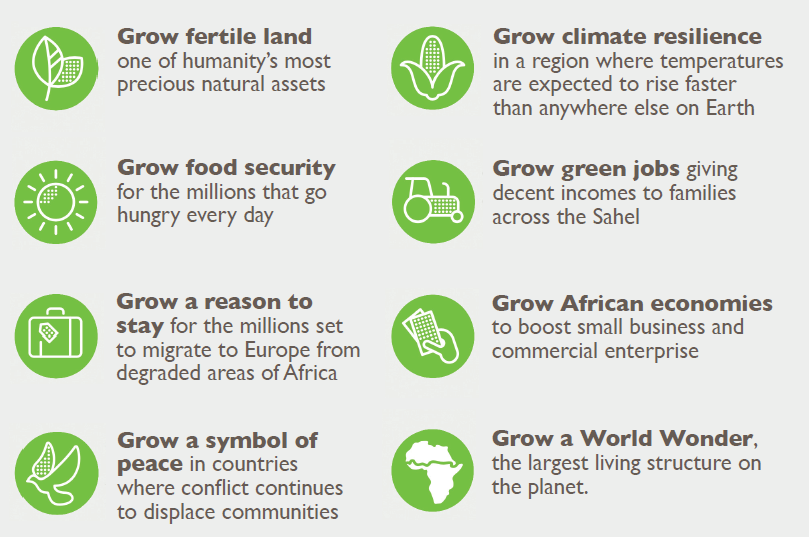The Great Green Wall
- Henk De Vlaeminck
- 10 ago 2016
- Tempo di lettura: 3 min
The Great Green Wall is an African-led project with an epic ambition: to grow an 8.000 km line of plants and trees across the entire African continent. Its goal is to provide food, jobs and a future for the millions of people who live in a region on the frontline of climate change. Once completed it will be the largest man-made structure on earth and a new wonder of the world.

The Great Green Wall stretches from Senegal in the West to Djibouti in the East.
The Sahel region, at the southern edge of the Sahara desert is one of the poorest places on the planet. More than anywhere else on Earth, the Sahel is on the frontline of climate change and millions of locals are already facing its devastating impact. Persistent droughts, lack of food, conflicts over fewer natural resources, and mass migration to Europe are some of the many consequences. Yet, local people from Senegal in the West to Djibouti in the East are fighting back.
The Great Green Wall for the Sahara and the Sahel Initiative (GGWSSI) is a pan-African programme launched in 2007 by the African Union (AU). Its goal is to reverse land degradation and desertification in the Sahel and Sahara, boost food security and support local communities to adapt to climate change. More than 20 countries are partners in the initiative, which also counts an array of regional and international organizations as key members.

The Great Green Wall is growing more than trees.
In Africa's Sahel and Sahara region, fertile drylands are a vital source of life to millions. Not only is this precious natural asset the basis for food security and agricultural production, it also generates employment and mitigates social crises for the region's most poverty stricken and vulnerable people.
An estimated 83 percent of rural Sub-Saharan Africans are dependent on livelihoods from the land, yet 40 percent of Africa's land resources are currently degraded, driving poverty, hunger, unemployment, forced migration and conflict while amplifying climate risks such as drought and floods.
The Great Green Wall isn’t just for the Sahel. It is global symbol for humanity overcoming its biggest threat – our changing environment. It shows that if we can work with nature, even in challenging places like in the Sahel, we can overcome adversity, and build a better world for generations to come.
The idea of making a green front against desertification is not new. Richard St. Barbe Baker (1889-1982) first proposed planting a band of trees across Africa to stop the southern advance of the Sahara in 1952, as he set out on an ecological expedition through the desert. “The Man of the Trees” as he was called, promoted his original proposal for the next thirty years. He called for a “Green Front” of trees across Africa 50 km wide. The current international initiative calls for a smaller 15 km wide “Green Wall” of trees.

Richard St. Barbe Baker at the conclusion of the First Sahara University Expedition, Nairobi, Kenya, 1953.
The Great Green Wall is a game-changer for Africa, with the potential to strengthen local resilience to climate change, preserve rural heritage and improve the living conditions of local populations.
The Great Green Wall, growing a World Wonder!
“The story of the Great Green Wall”, 30 Nov 2015, Great Green Wall, Youtube.com
The Great Green Wall initiative brings together many countries, local communities and international partners in a mosaic of big and small-scale projects. You know about one of these projects? Tell us about it!
The Author recommends the following books on the subject:
Combating Desertification in Asia, Africa and the Middle East: Proven practices 2013th Edition
by G. Ali Heshmati (Editor), Victor Squires (Editor)
This compilation demonstrates that desertification and land degradation can be controlled and reversed with existing techniques in such widely varying environments as the Sahel of Africa to Sri Lanka and the Philippines in SE Asia, from high elevation in Lesotho to low lands on desert margins in Mongolia.
The contributors are local experts working in-country and bring to the book insights into many little-known aspects of the technical, ecological, social, cultural and economic factors determine success or failure of desertification control efforts.
Click the image to get more information.
Men of the trees; September 1, 2011
by Richard St. Barbe Baker (Author)
This is a reproduction of a book published before 1923. It has occasional imperfections such as missing or blurred pages, poor pictures, errant marks, etc. but it is a valuable "cultural artifact".
Click the image to get more information.
#GreatGreenWall #Africa #manmadestructure #wonderoftheworld #Sahel #Sahara #climatechange #droughts #massmigration #Senegal #Djibouti #UNFAO #FAO #GGWSSI #AfricanUnion #fertileland #foodsecurity #climateresilience #greenjobs #WorldWonder #RichardStBarbeBaker #ManoftheTrees #GreenFront #growingaworldwonder









































Comments